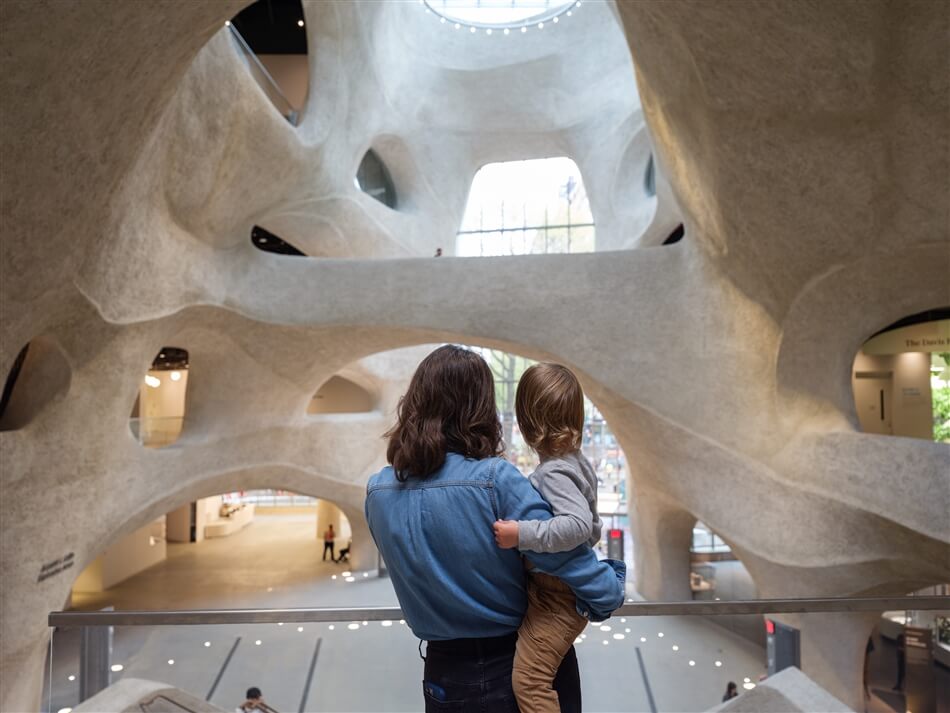
Richard Gilder Center for Science, Education, and Innovation
American Museum of Natural History, New York
May 04, 2023
American Museum of Natural History to open its Richard Gilder Center for Science, Education, and Innovation, ushering in a new year for the museum, New Yorkers, and visitors from around the World.
Hailed internationally as a soaring architectural achievement, and housing world-class research facilities and scientific collections, next-generation classrooms, and innovative exhibitions, the American Museum of Natural History’s highly anticipated Richard Gilder Center for Science, Education, and Innovation will open to the public on May 4, catapulting the Museum into an exciting new era.

The Gilder Center embodies the Museum’s mission of science and education in every way-from sparking curiosity and wonders through new exhibits in strikingly designed spaces to providing new facilities where research collections, exhibitions, and learning are situated in close proximity, reinforcing the central role of natural history collections in scientific discovery and providing deeper experiences that connect visitors to the evidence and processes of science through engaging exhibits and programs. At the same time, the new building also enhances the visitor experience by establishing continuous pathways through its four-block campus, connecting buildings that were constructed over the course of nearly 150 years.

Designed by Studio Gang, the international architecture and urban design practice led by Jeanne Gang, the Gilder Center is the latest in a series of major projects over the last three decades that have transformed the Museum’s campus, its science, educational and exhibition spaces, and all four facades, including Central Park West and the 77th Street “castle” façade, which have been thoughtfully restored.

The 230,000-square-foot $465 million Gilder Center project was announced in 2014 and includes six floors above ground, four of which are open to the public, and one below. It creates 33 connections among 10 Museum buildings to link the entire campus and establishes a new entrance on the Museum’s west side, at Columbus Avenue and 79th Street, in Theodore Roosevelt Park. Visitors coming from Columbus Avenue experience the Gilder Center as a building set in a park, constructed at the same height as the older Museum buildings that flank it, with flowing, gentle curves. Adjacent areas of the park have been enhanced with a new landscape design, developed by Reed Hilderbrand with community input, which features more pathways and seating areas.

“The Gilder Center is designed to invite exploration and discovery that is not only emblematic of science but also such a big part of being human. It aims to draw everyone in – all ages, backgrounds, and abilities – to share the excitement of learning about the natural world,” said Jeanne Gang, founding principal and partner of Studio Gang. “Stepping inside the large daylit atrium, you are offered glimpses of the different exhibits on multiple levels. You can let your curiosity lead you. And with the many new connections that the architecture creates between buildings, it also improves your ability to navigate the Museum’s campus as a whole.”

The texture, colour, and flowing forms of the Griffin Atrium were inspired by canyons in the southwestern U.S. and animate the Gilder Center’s grand entrance, evoking awe, excitement, and discovery. Its striking structure has been built by spraying concrete directly onto rebar without traditional formwork in a technique known as “shotcrete,” invented in the early 1900s by Museum naturalist and taxidermy artist Carl Akeley. The bridges and openings in the hand-finished shotcrete connect visitors physically and visually to multiple levels housing new exhibition galleries, designed by Ralph Appelbaum Associates with the Museum’s Exhibition Department, education spaces, and collections facilities, creating welcoming sightlines that encourage movement into and throughout the building. The verticality of the Griffin Atrium also acts as a key sustainability feature, providing natural light and air circulation to the heart of the building’s interior.

A broad, grand staircase on the east side of the Griffin Atrium, on the axis with the entrance, is designed with one side as seating steps, featuring deep, walnut-covered treads and high risers that offer visitors a place to gather for rest and conversation and can be used as seating for programs. With improved circulation provided by the Gilder Center, Museum visitors will be able to proceed from the entrance on Columbus Avenue all the way through to Central Park West, or vice-versa.

Visitors will be able to explore three levels of spectacular displays featuring more than 3,000 objects and representing every area of the Museum’s collections in vertebrate and invertebrate zoology, palaeontology, geology, anthropology, and archaeology, with materials ranging from dinosaur tracks to astronomical instruments, and from antlers to pottery. A series of digital exhibits feature stories about how scientists analyze various types of collections and introduce Museum researchers, while the glass-panelled exhibits, including those in the Macaulay Family Foundation Collection Galleries on the first and second floors, offer visitors glimpses into working collections areas situated behind the displays. Together with the collections stored in the new Lepidoptera facility, which is also visible to visitors and is located next to the Collections Core on the second floor, the Gilder Center houses more than 4 million scientific specimens.
more. www.amnh.org


